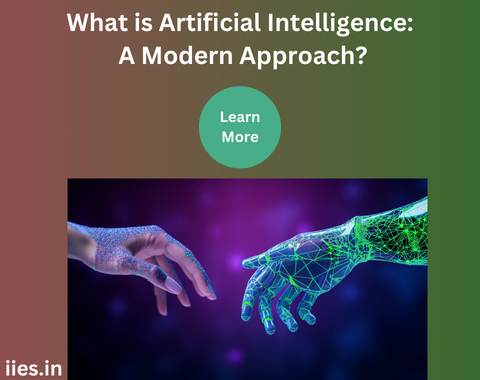
In the ever-evolving landscape of technology, Artificial Intelligence (AI) stands out as a transformative force that is reshaping the way we live, work, and interact with the world around us.
A modern approach to AI involves a multidisciplinary blend of computer science, mathematics, and cognitive science to create intelligent systems capable of learning, reasoning, and problem-solving.
This article explores the foundations, applications, and ethical considerations of AI, highlighting the advancements that define the modern approach to this groundbreaking field.
The roots of AI can be traced back to the mid-20th century when pioneers like Alan Turing and John McCarthy laid the groundwork for intelligent machines. The Turing Test, proposed by Alan Turing in 1950, set the stage for assessing a machine’s ability to exhibit human-like intelligence in its responses. John McCarthy, on the other hand, coined the term “artificial intelligence” in 1956, marking the birth of a field that would revolutionize technology.
A key aspect of the modern approach to AI is machine learning, a subset that focuses on enabling machines to learn from data. This departure from rule-based programming allows systems to adapt and improve their performance over time. Supervised learning, unsupervised learning, and reinforcement learning are some of the key paradigms within machine learning that drive the development of intelligent systems.
Modern AI leverages a variety of algorithms and models to process and interpret vast amounts of data. Deep learning, a subset of machine learning, has gained prominence for its ability to automatically learn hierarchical representations of data through artificial neural networks. Convolutional Neural Networks (CNNs) excel in image recognition tasks, while Recurrent Neural Networks (RNNs) are proficient in processing sequential data, such as language and speech.
Natural Language Processing (NLP) is another critical aspect of AI that empowers machines to understand, interpret, and generate human language. Applications like virtual assistants, language translation, and sentiment analysis showcase the practical implications of NLP in our daily lives.
The modern approach to AI is evident in its widespread applications across various industries. In healthcare, AI is revolutionizing diagnostics through image analysis, predicting disease outbreaks, and personalizing treatment plans. Autonomous vehicles are a tangible outcome of AI in the transportation sector, showcasing the ability of machines to navigate complex environments.
Businesses leverage AI for data analytics, customer relationship management, and supply chain optimization. AI-driven chatbots enhance customer support by providing instant and personalized assistance. The financial sector benefits from AI in fraud detection, risk assessment, and algorithmic trading, where machines can analyze vast datasets to make informed decisions.
Issues such as bias in algorithms, job displacement due to automation, and concerns about privacy and security demand careful scrutiny. The modern approach to AI necessitates a commitment to fairness, transparency, and accountability.
Addressing bias in AI algorithms requires diverse and inclusive datasets, as well as ongoing efforts to audit and mitigate unintended consequences. Ethical frameworks and guidelines are essential for guiding the responsible development and deployment of AI technologies. Striking a balance between innovation and ethical considerations is crucial to ensuring that AI benefits society at large.
Challenges and Future Prospects
While AI has made remarkable strides, challenges persist. Explainability, or the ability to interpret and understand the decisions made by AI systems, remains a significant hurdle. Trust in AI is contingent on the transparency of its decision-making processes.
Interdisciplinary collaboration is key to addressing the challenges and unlocking the full potential of AI. Collaboration between computer scientists, ethicists, policymakers, and industry leaders can foster a holistic approach to AI development. Continued research and investment in AI technologies will drive innovation and pave the way for future breakthroughs.
The Evolution of Artificial Intelligence
The journey of artificial intelligence is marked by continuous evolution, and the modern approach represents a departure from traditional rule-based systems. Early AI systems were confined to predefined rules, limiting their adaptability and learning capabilities. The contemporary shift towards machine learning and deep learning models allows AI systems to discern patterns, adapt to new information, and improve their performance through experience.
Machine Learning and Neural Networks
At the heart of the modern AI paradigm is machine learning, where algorithms learn from data rather than being explicitly programmed. This approach enables AI systems to tackle complex problems, such as image and speech recognition, with unprecedented accuracy. Neural networks, inspired by the structure and functioning of the human brain, have become the cornerstone of machine learning. The layers of interconnected nodes in neural networks simulate the intricate connections between neurons, enabling the system to recognize intricate patterns and correlations.
Deep learning, a subset of machine learning, introduces neural networks with multiple layers (deep neural networks). This architecture enhances the system’s ability to abstract and comprehend intricate features within data, leading to breakthroughs in areas like natural language processing and computer vision.
Natural Language Processing (NLP) and Conversational AI
The integration of NLP into AI systems has ushered in a new era of human-computer interaction. Modern applications of NLP range from virtual assistants like Siri and Alexa to language translation tools that bridge global communication gaps. Conversational AI, powered by advanced language models, enables machines to engage in nuanced and context-aware dialogues, creating a more natural and user-friendly experience.
AI in Creativity and Innovation
Beyond problem-solving and data analysis, AI is extending its influence into creative domains. Generative models, such as OpenAI’s GPT (Generative Pre-trained Transformer) series, demonstrate the ability to generate human-like text, opening avenues for content creation, storytelling, and even poetry.
Artificial Intelligence, with its modern approach grounded in machine learning, deep learning, and natural language processing, is reshaping the fabric of our technological landscape. From healthcare to finance, AI is making an indelible mark on various industries, enhancing efficiency, and introducing new possibilities. However, ethical considerations must be at the forefront of AI development to ensure that these advancements benefit humanity responsibly.
Indian Institute of Embedded Systems – IIES